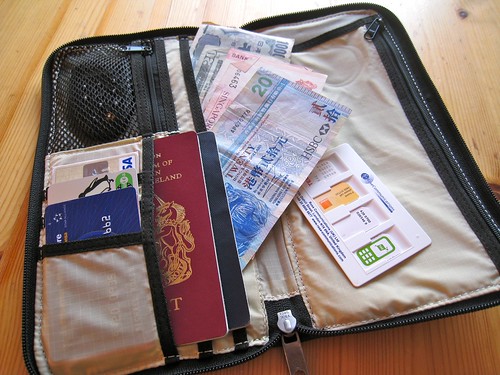Make the Most of London City Airport
Wednesday, November 12th, 2014 by Kate GoldstoneWhat do you know about London City Airport? The chances are unless you use it, you don’t know much about it.
London City is perhaps the capital’s least-familiar airport, nowhere near as well known as the big four, Gatwick, Stansted, Luton and Heathrow. In fact it’s the only airport actually in London itself, a mere 22 minutes away from Bank station, making it the perfect solution when you’re flying in or out of the capital itself.

London City Airport Logo
About London City Airport – One of the Capital’s Big Five
We thought it’ be useful to take a look at London City Airport facts and facilities, to help you make the most of the experience.
Where is London City Airport?
“located on a former Docklands site in the London Borough of Newham, some 11km (6.9 miles) east of the City of London and a smaller distance east of Canary Wharf. These are the twin centres of London’s financial industry, which is a major user of the airport.”
The full street address is The Royal Docks, Hartmann Road, London E16 2PX.
Getting to London City Airport
Being located in the city centre, the airport is impressively convenient for public transport but less so for cars and other vehicles. There’s a very good reason for this, their dedicated Travel Plan dating back to 2011. Here’s what they say about it:
“As part of our commitment to a range of measures to reduce the environmental impact of the Airport’s operation, London City Airport’s surface access strategy is to actively encourage its staff, passengers and visitors to use sustainable modes of transport to access the Airport site. Surface access at the airport is monitored and managed through the London City Airport Travel Plan (2011).”
The Plan has formalised targets to reduce the number of single occupancy vehicles travelling to and from the site, in an effort to cut the impact that the airport’s staff, passengers and visitors have on the surrounding road network and the resulting air pollution.

London City Airport Station
High air pollution? Leave your vehicle and travel by public transport
There’s even a link to DEFRA on the airport website designed to tell you how high or low air pollution levels are likely to be on the day you’re travelling. If they’re high or very high, you’re strongly advised to leave your car at home to avoid making things even worse.
If you really can’t avoid using a car, there’s a handy route finder tool on the official airport website, here. All you do is enter the postcode of the place you’re travelling from, and you can also print the route suggested by the tool.
What are the public transport links like?
London City has excellent public transport links including the rapid Docklands Light Railway, which links to the Tube network as well as national railway stations. There’s a wide choice of buses, licensed London minicabs and taxis, trains and chauffeur services available. In fact the public transport links to and from the airport are so good that in 2008, Business Traveller magazine named it the airport with the best public transport links in the world.
London City Airport destinations
Flights from London city airport go to 45 or so key destinations, all taking off from a single, long runway. The destinations on offer include a generous handful of internal flights within the British Isles, namely Aberdeen, Belfast, Dublin, Edinburgh, Exeter, Glasgow, Guernsey, Inverness, the Isle of Man and Jersey.
London City Airport departures to European destinations include:
- Angers
- Amsterdam
- Antwerp
- Avignon
- Billund
- Brest
- Brive
- Chambery
- Deauville
- Dresden
- Dusseldorf
- Florence
- Faro
- Frankfurt
- Geneva
- Grenada
- Ibiza
- Hamburg
- Luxembourg
- Madrid
- Milan
- Mahon
- Malaga
- Nice
- Quimper
- Nantes
- Paris Orly
- Palma, Mallorca
- Rome
- Rotterdam
- Toulon
- Venice
- Zurich
You can also catch flights to New York’s JFK airport from London City. All of which makes it a particularly convenient starting point for and business travel.
If you’d like to check our London City Airport arrivals and departures in real time, here’s a link to their live, real-time departures and arrivals boards.

London City Airport Destinations from londoncityairport.com
How busy does it get?
In 2013 the airport catered for an impressive 3.3 million passengers, a 12% increase on the previous year and a figure that made it the fifth business London airport behind Heathrow, Gatwick, Stansted and Luton as well as Britain’s 15th busiest.
Hotels near London city airport
Being so central, the wonderful world of London hotels is at your fingertips, with everything from 5 star mega-luxury to basic B&Bs. There are literally hundreds of hotels in the vicinity and at least 25 close to the airport itself, including the four star Ramada Hotel & Suites at London Docklands and the Crowne Plaza, also at London Docklands.
Want a recommendation? The Aloft London comes in for particularly good reviews. It’s an incredibly smart 4 star hotel in Canary Wharf itself, a stone’s throw from the Excel Exhibition Centre and a masterpiece in eco-friendliness. Convenient for the O2 Arena and Boleyn Ground Stadium, it’s right on the doorstep of the Emirates Air Line Royal Docks Station and the magnificent Thames Barrier. Here’s what you get.
- Restaurant
- Indoor pool
- Bar/lounge
- Free wireless internet in the hotels and in the rooms
- Irons/ironing boards
- Private bathrooms with wonderful rainfall showerheads
- Self-parking
- Connecting / adjoining rooms available
- Flat screen TV
- Daily housekeeping services
- Rooms with a shower only if that’s what you prefer
- Free cots for little children if you need them
- Every room individually furnished

London City Airport Take Off from cityjet.com
Parking at London city airport
As we’ve already mentioned, LCA is keen to minimise vehicles at the airport and actively promotes the area’s legendary public transport links. As such parking there isn’t cheap, costing £6 for 0-30 minutes in short stay at the terminal and £20 for just 0-4 hours in long stay. The message is clear: it’s best to leave your vehicle at home!
If that’s not possible, the airport provides terminal/short term parking and long term parking. Short stay parking is just 2 minutes from the terminal, long stay is also very close to the action, a maximum of 7 minutes away.
There’s free motorbike and bicycle parking under the DLR viaduct in front of the terminal and discounted rate disabled car parking in the short stay car park.
Airport facilities
What about the usual home comforts you’d expect from any decent airport? Here’s what you’ll find on tap:
- A concierge service
- Car hire
- Free WiFi
- Currency exchange facilities
- Two spotless outlets servinghot and cold drinks and freshly cooked food
- Left luggage
- Shoe shine
- A WH Smith and a WH Smith book shop
- Duty Free shopping in Departures, after Security
- Boots
- Links of London – jewellery
The views…
As you’d expect from an airport sited in England’s capital city, the views at take-off and landing are absolutely spectacular.

London City Airport from global-infra.com
You’ll see the entire city unfolding beneath you in all its glory, everything from Docklands itself and the Millennium Dome to the city’s many splendid pieces of contemporary architecture, ancient monuments, beautiful green parklands, royal palaces, crowded shopping streets, museums and gracious tree-lined avenues.
For that reason alone, it’s well worth starting and ending your journey at London City Airport!




























